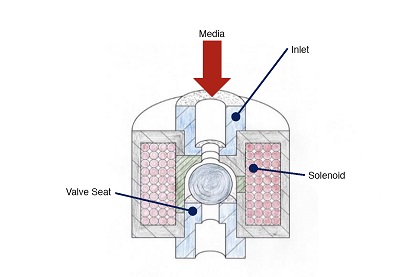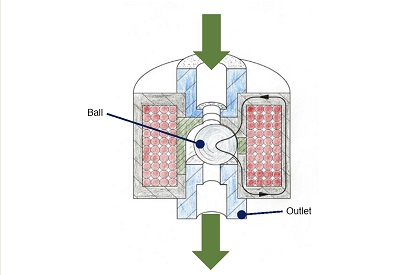The SmartValve from KTW Technology, Wehr, Germany, is a new type of flow-control valve that relies on a magnetized ball as the fluid-control element. This ultrafast switching valve is designed for high-speed pulsing of airflow, making it well suited for compressed-air blow-off, cooling, cleaning and drying applications where it reportedly brings higher efficiency and performance.

It can also handle other gases and liquids, offering similar benefits in dosing systems, agricultural sprayers, water injectors that reduce combustion-engine emissions, and many other applications that demand better control and sizable energy savings.
SmartValve technology was originally developed by the German Aerospace Center (DLR) for the European space mission Rosetta, as a cold gas control valve for the Philae lander – the craft which made the first-ever soft landing on a comet nucleus. Over the last few years KTW engineers have further refined the valve design for industrial applications, produced a range of sizes, and developed the power electronics that provides closed-loop control.
The SmartValve features a simple, robust and reliable design. The only moving internal part is a ball that opens and closes the valve. No other components like springs or membranes are necessary.

At rest, a pressure differential between the valve inlet and outlet keeps the ball on the valve seat. To actuate the valve, electric current energizes a solenoid coil in the valve housing. The resulting magnetic field force laterally pulls the ball off the seat — permitting flow. Shutting off power eliminates the magnetic field, flow forces return the ball back to the seat, and the valve closes. Extremely fast (1 msec), direct and stochastic switching allows for real-time applications. The fail-safe valve closes automatically in case of power loss.
SmartValves typically operate with pressure differentials of between 1 and 10 bar (14.5 to 145 psi), and system pressures can range up to 1,000 bar. Customized versions address special customer requirements. KTW has developed valves to work at pressure differentials of approximately 600 bar and at temperatures as low as -200° C (-328° F) and as high as 400° C (752° F).
Ball and valve seat diameters, and the magnetic system, determine operating characteristics like opening force and switching speed. Varying these parameters lets engineers easily adapt the valve to suit different requirements and applications. For example, applying higher current opens the valve faster, although actual switching speed depends on the fluid and pressure differential. Accuracy depends on the size of the valve and the fluid forces but, in general, pulse-to-pulse repeatability is extremely high, provided that the pressure differential is fairly constant.
The ball, seat and other parts in contact with media are made of stainless steel, and working surfaces are polished. However, certain plastics, such as PEEK, can be used for the valve seat if required. Thanks to the low-friction, low-wear design and minimal mechanical load, the valve has an extremely long service life of more than three billion switching cycles.
The valve resists corrosion and KTW engineers recommend use with particle-free media or installing proper filtration to extract solid contaminants. Unchecked, dirt and debris could lodge between ball and seat and lead to leakage past the valve. Maintenance technicians can remove troublesome contamination by opening the valve and cleaning the seat. Damaged balls and seats are easily replaced.
The valve can be used for a single pulse, a limited or very long sequence of pulses, and it can also be held open for long periods of time. In essence, the valve stays open as long as there is a current applied to the solenoid. The length of the pulses can be manipulated via parameters in KTW’s proprietary Controller Output Stage (for example, open-time, close-time, frequency and number of pulses). Between fully closed (zero flow rate) and fully open (maximum flow rate) users can adjust the flow rate to every value by varying the pulsing length and frequency – which means it can also serve as a proportional valve.
Fast opening and closing of the valve requires a high operating voltage. The Output Stage combines an operating voltage of up to 48 V with closed-loop current control of up to 12 A per channel. Alternatively, it supplies 24 V for lower performance/lower speed applications (two valves per output stage). However, actual power consumption is relatively low because maximum power is only required for the very short duration needed to overcome pressure forces and lift the ball off the seat. Communication with the system is via intuitive software (USB interface) or a CANbus network. Thus, users can manipulate valve/pulsing parameters in real time.
KTW offers the SmartValve in four standard valve sizes. The smallest permits maximum flow rate of about 14 m3/hr (8.24 cfm); the largest approximately 75 m3/hr (44.14 cfm). Also, a three-ball version produces maximum flow of 85 m3/hr (50.03 cfm).
In pulsing compressed-air applications such as blow-off, cleaning, drying and parts ejection, systems using the SmartValve reportedly reduce compressed air-consumption by 60% to 90% — resulting in significant energy savings. Just as important, it improves process quality, as the pulsed beam generates about 15 to 20% higher impulse force compared to a continuous flow. That, in turn, can speed processes and improve productivity.
PHIR Technologies, Hartland, Wis., represents KTW Technology GmbH in North America.
KTW Technology
ktwsystems.com
Filed Under: Pneumatic Tips